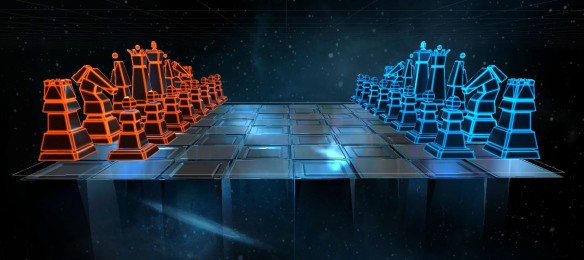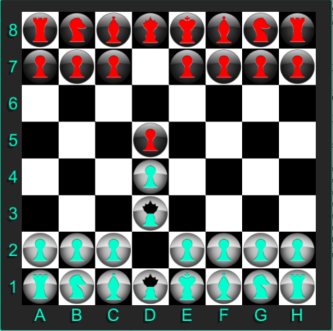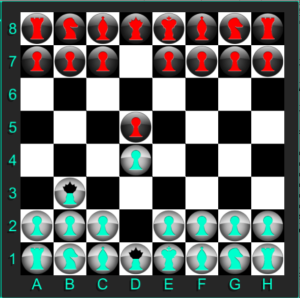Two years ago, as a graduate student in Physics at USC, I began work on a game whose mechanics were based on quantum mechanics. When I had a playable version ready, my graduate adviser, Todd Brun, put me in contact with IQIM’s Spiros Michalakis, who had already worked with Google to design qCraft, a mod introducing quantum mechanics into Minecraft. Spiros must have seen potential in my clunky prototype and our initial meeting turned into weekly brainstorming lunches at Caltech’s Chandler cafeteria. More than a year later, the game had evolved into Quantum Chess and we began talking about including a video showing some gameplay at an upcoming Caltech event celebrating Feynman’s quantum legacy. The next few months were a whirlwind. Somehow this video turned into a Quantum Chess battle for the future of humanity, between Stephen Hawking and Paul Rudd. And it was being narrated by Keanu Reeves! The video, called Anyone Can Quantum, and directed by Alex Winter, premiered at Caltech’s One Entangled Evening on January 26, 2016 and has since gone viral. If you haven’t watched it, now would be a good time to do so (if you are at work, be prepared to laugh quietly).
So, what exactly is Quantum Chess and how does it make use of quantum physics? It is a modern take on the centuries-old game of strategy that endows each chess piece with quantum powers. You don’t need to know quantum mechanics to play the game. On the other hand, understanding the rules of chess might help [1]. But if you already know the basics of regular chess, you can just start playing. Over time, your brain will get used to some of the strange quantum behavior of the chess pieces and the battles you wage in Quantum Chess will make regular chess look like tic-tac-toe [2].
 In this post, I will discuss the concept of quantum superposition and how it plays a part in the game. There will be more posts to follow that will discuss entanglement, interference, and quantum measurement [3].
In this post, I will discuss the concept of quantum superposition and how it plays a part in the game. There will be more posts to follow that will discuss entanglement, interference, and quantum measurement [3].
In quantum chess, players have the ability to perform quantum moves in addition to the standard chess moves. Each time a player chooses to move a piece, they can indicate whether they want to perform a standard move, or a quantum move. A quantum move creates a superposition of boards. If any of you ever saw Star Trek 3D Chess, you can think of this in a similar way.

Star Trek 3D Chess
There are multiple boards on which pieces exist. However, in Quantum Chess, the number of possible boards is not fixed, it can increase or decrease. All possible boards exist in a superposition. The player is presented with a single board that represents the entire superposition. In Quantum Chess, any individual move will act on all boards at the same time. Each time a player makes a quantum move, the number of possible boards present in the superposition doubles. Let’s look at some pictures that might clarify things.
The Quantum Chess board begins in the same configuration as standard chess.
 All pawns move the same as they would in standard chess, but all other pieces get a choice of two movement types, standard or quantum. Standard moves act exactly as they would in standard chess. However, quantum moves, create superpositions. Let’s look at an example of a quantum move for the white queen.
All pawns move the same as they would in standard chess, but all other pieces get a choice of two movement types, standard or quantum. Standard moves act exactly as they would in standard chess. However, quantum moves, create superpositions. Let’s look at an example of a quantum move for the white queen.
 In this diagram, we see what happens when we perform a quantum move of the white queen from D1 to D3. We get two possible boards. On one board the queen did not move at all. On the other, the queen did move. Each board has a 50% chance of “existence”. Showing every possible board, though, would get quite complicated after just a few moves. So, the player view of the game is a single board. After the same quantum queen move, the player sees this:
In this diagram, we see what happens when we perform a quantum move of the white queen from D1 to D3. We get two possible boards. On one board the queen did not move at all. On the other, the queen did move. Each board has a 50% chance of “existence”. Showing every possible board, though, would get quite complicated after just a few moves. So, the player view of the game is a single board. After the same quantum queen move, the player sees this:
 The teal colored “fill” of each queen shows the probability of finding the queen in that space; the same queen, existing in different locations on the board. The queen is in a superposition of being in two places at once. On their next turn, the player can choose to move any one of their pieces.
The teal colored “fill” of each queen shows the probability of finding the queen in that space; the same queen, existing in different locations on the board. The queen is in a superposition of being in two places at once. On their next turn, the player can choose to move any one of their pieces.
So, let’s talk about moving the queen, again. You may be wondering, “What happens if I want to move a piece that is in a superposition?” The queen exists in two spaces. You choose which of those two positions you would like to move from, and you can perform the same standard or quantum moves from that space. Let’s look at trying to perform a standard move, instead of a quantum move, on the queen that now exists in a superposition. The result would be as follows:
 The move acts on all boards in the superposition. On any board where the queen is in space D3, it will be moved to B5. On any board where the queen is still in space D1, it will not be moved. There is a 50% chance that the queen is still in space D1 and a 50% chance that it is now located in B5. The player view, as illustrated below, would again be a 50/50 superposition of the queen’s position. This was just an example of a standard move on a piece in a superposition, but a quantum move would work similarly.
The move acts on all boards in the superposition. On any board where the queen is in space D3, it will be moved to B5. On any board where the queen is still in space D1, it will not be moved. There is a 50% chance that the queen is still in space D1 and a 50% chance that it is now located in B5. The player view, as illustrated below, would again be a 50/50 superposition of the queen’s position. This was just an example of a standard move on a piece in a superposition, but a quantum move would work similarly.
Some of you might have noticed the quantum move basically gives you a 50% chance to pass your turn. Not a very exciting thing to do for most players. That’s why I’ve given the quantum move an added bonus. With a quantum move, you can choose a target space that is up to two standard moves away! For example, the queen could choose a target that is forward two spaces and then left two spaces. Normally, this would take two turns: The first turn to move from D1 to D3 and the second turn to move from D3 to B3. A quantum move gives you a 50% chance to move from D1 to B3 in a single turn!
Let’s look at a quantum queen move from D1 to B3.
 Just like the previous quantum move we looked at, we get a 50% probability that the move was successful and a 50% probability that nothing happened. As a player, we would see the board below.
Just like the previous quantum move we looked at, we get a 50% probability that the move was successful and a 50% probability that nothing happened. As a player, we would see the board below.
 There is a 50% chance the queen completed two standard moves in one turn! Don’t worry though, things are not just random. The fact that the board is a superposition of boards and that movement is unitary (just a fancy word for how quantum things evolve) can lead to some interesting effects. I’ll end this post here. Now, I hope I’ve given you some idea of how superposition is present in Quantum Chess. In the next post I’ll go into entanglement and a bit more on the quantum move!
There is a 50% chance the queen completed two standard moves in one turn! Don’t worry though, things are not just random. The fact that the board is a superposition of boards and that movement is unitary (just a fancy word for how quantum things evolve) can lead to some interesting effects. I’ll end this post here. Now, I hope I’ve given you some idea of how superposition is present in Quantum Chess. In the next post I’ll go into entanglement and a bit more on the quantum move!
Notes:
[1] For those who would like to know more about chess, here is a good link.
[2] If you would like to see a public release of Quantum Chess (and get a copy of the game), consider supporting the Kickstarter campaign.
[3] I am going to be describing aspects of the game in terms of probability and multiple board states. For those with a scientific or technical understanding of how quantum mechanics works, this may not appear to be very quantum. I plan to go into a more technical description of the quantum aspects of the game in a later post. Also, a reminder to the non-scientific audience. You don’t need to know quantum mechanics to play this game. In fact, you don’t even need to know what I’m going to be describing here to play! These posts are just for those with an interest in how concepts like superposition, entanglement, and interference can be related to how the game works.


Pingback: Ya conocemos al ganador del primer torneo de ajedrez cuántico: una versión más compleja con superposiciones y entrelazamientos – Think'IT
Pingback: Ya conocemos al ganador del primer torneo de ajedrez cuántico: una versión más compleja con superposiciones y entrelazamientos – Radio Región
Pingback: Ya conocemos al ganador del primer torneo de ajedrez cuántico: una versión más compleja con superposiciones y entrelazamientos – RBD Noticias
Pingback: Ya conocemos al ganador del primer torneo de ajedrez cuántico: una versión más compleja con superposiciones y entrelazamientos – InfoSalud24
Pingback: Ya conocemos al ganador del primer torneo de ajedrez cuántico: una versión más compleja con superposiciones y entrelazamientos – Aragon Innova
Pingback: Ya conocemos al ganador del primer torneo de ajedrez cuántico: una versión más compleja con superposiciones y entrelazamientos - La Fragua
Pingback: Defending quantum chess champion takes the title again in 2021 tournament - Tech Scurry - The Latest Tech News Of The World
Pingback: Defending quantum chess champion takes the title again in 2021 tournament
Pingback: Defending Quantum Chess Champion Takes The Title Once More In 2021 Match - ITechBlog
Pingback: Defending quantum chess champion takes the title again in 2021 tournament Space Channel
Pingback: Nous avons un gagnant dans le premier tournoi d'échecs quantique au monde | Nouvelles techniques